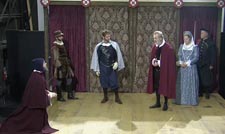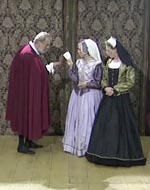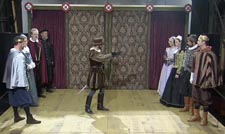- Edition: King Leir
King Leir
- Introduction
- Texts of this edition
- Contextual materials
- Facsimiles
190King Leir, Scene 30
Cast
Gallia: Paul Hopkins
Leir: Don Allison
Chief of the Town: David Kynaston
Mumford: Alon Nashman
Cordella: Julian DeZotti
Perillus: Peter Higginson
Cornwall: Jason Gray
Cambria: Scott Clarkson
Gonorill: Matthew Krist
Ragan: Derek Genova
Queen's Men Dramaturgy: The Medley Style (Sc. 30)
191Read about the Queen's Men medley style in Scene 27
Our opening skirmishes were so ridiculous that it was tempting to take the whole battle ironically and play it for fun. But the text of scene 30 does not invite a uniformly comic treatment, given that Leir's confrontation with his parricidal daughters is written as high drama. For example, Leir's attack on Ragan, "Out on thee, viper, scum, filthy parricide,/More odious to my sight than is a toad" (TLN 2585-6), suggests a deep emotional engagement.
192Performing certain scenes in this play, like the aborted murder scene, it was necessary to balance the comic with the serious. At other moments, like this one, the company needed to shift from one mode to the other in an instant. As the SQM company's actors gained more experience performing the Queen's Men's plays, they became increasingly adept at doing so. The company turned the mood here by first investing the "chief of the town" with a deeply felt response to the return of his king, and second by the strength and power of Cornwall and Cambria's attacks on the invaders.
The Queen's Men and Shakespeare (Sc. 30)
193Read about the Queen's Men and Shakespeare in Scene 25
Cordella, Leir, and Perillus all pray to God to "shield" Gallia "from all harms" and ensure that "victory may prosecute the right" (TLN 2540). Their speeches appeal to the chivalric principle that success in battle proves the justice of the victor's cause. God's providential hand has been apparent throughout the Queen's Men play and there is little doubt at this point who is going to win the battle. Shakespeare also makes repeated reference in his play to chivalric justice (Edgar's challenge to Edmundfor example, is announced with formal tuckets) but he then subverts the audience expectations by rising and surprising them with the death of Cordelia and her father. With the happy ending of the Queen's Men's play as a reference point for some members of the audience, Shakespeare's ploy would surely have been all the more shocking.
Performing Cordella (Sc. 30)
194Read about performing Cordella in Scene 21
Once the battle is begun Cordella is sidelined in the action as one that is "feeble" and wants "use of arms" (TLN 2539), though she still shows her strength in confrontation with her sister (TLN 2575-6). She becomes here an exemplum of the dutiful woman, deferring to her husband and her father.
Read more about performing Cordella.
Performing Cornwall and Cambria (Sc. 30)
195Read about performing Cornwall and Cambria in Scene 22
The bumbling knights errant of earlier scenes were set aside here momentarily - they return as they lose the battle and flee the stage - to be replaced by aggressive antagonists defending their rights.
Read about performing Cornwall and Cambria in earlier scenes.
Performing Mumford (Sc. 30)
196Read about performing Mumford in Scene 29.
In spite of the shift in tone, Mumford is still given comic opportunities, first when thanking Leir for the opportunity to fight for him against "naked women" (TLN 2538) and second when expressing his disappointment that Gonorill and Ragan's "good faces/Should have so little grace between them" (TLN 2607).
Read more about performing Mumford.
Watch video of Scene 30 on the Performing the Queen's Men website. (The video footage is password protected. Click on "Cancel" in the pop-up window to obtain password.)
Performing Gonorill and Ragan (Sc. 30)
197Read about performing Gonorill Scene 12 and Ragan in Scene 22
The sisters remain resolutely committed to wickedness right through to the end, lying openly to defend their position and to ensure their husbands fight the invaders. The SQM company "boys" took great relish in their barefaced lies ( "What hours? What thicket?" (TLN 2594), their disrespect to their father and Perillus ( "Peace, peace, old fellow, thou art sleepy still") (TLN 2603), and their aggression to their sister "Peace, puritan, dissembling hypocrite" (TLN 2577). Their wickedness was the exact counterpoint to the pious dedication shown by Leir, Perillus, and Cordella immediately before their arrival (TLN 2539-2546). For our modern audience, their blatant wickedness verged on the humorous in spite of the company's emotional investment in the scene. One wonders whether their actions and words would have been amusing in this way within a Christian and patriarchal society. I suspect the scene would have been more shocking to its original audience and worked to affirm the moral perspective of the play that values Cordella's strong but dutiful femininity over the unleashed power of Ragan and Gonorill.
The Queen's Men Stage Directions (Sc. 30)
198Read about the Queen's Men stage directions in Scene 29
This scene was extremely difficult to block on our postage stamp stage as it involves so many characters. Imagining how the company would block such a scene with limited rehearsal time we came up with the idea that the opposing groups of characters should line up on either side of the stage and that when it was their turn to speak, they would step forward and then return to their side once they had finished. This protocol worked pretty well except for characters with single lines. Gonorill, for example, first speaks a single line (TLN 2570) and it was ungainly to have her step forward to speak that line and then return to the side only to step forward again shortly afterwards. She therefore remained in the forward position and was joined by her sister. The sisters then confronted Cordella, Leir and Perillus together as each stepped forward to challenge them.
199The blocking protocol worked reasonably well and was something the company could use as a basis for the scene and adapt when performing in different locations. On our regular stage, the scene remained cluttered and created all sorts of sightline issues for audience members at the side of the stage, but the final performance, recorded on video, took place on a larger stage in University Hall at the University of Toronto. Here the blocking worked a little better because there was enough space between the actors on the side of the stage to allow for greater visibility. Watching the video, however, you will notice audience members leaning to get a view of the actors' faces on the other side of the stage. On a larger stage, such as the stage at the Globe, this scene would have been easier to manage with the opposing groups assembling at the upstage corners. Using this technique on our small stage would have meant the two parties would be standing about two feet apart.
Read more about the Queen's Men stage directions.
Watch video of Scene 30 on the Performing the Queen's Men website. (The video footage is password protected. Click on "Cancel" in the pop-up window to obtain password.)




